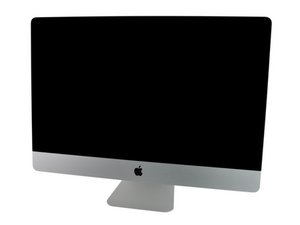Black screen after SSD install (suspect is monitor cables)
Hi ifixit
___________________________
I'm having black screen(internal monitor) after ssd install.
Here is more details a short & long description:
Short description:
- opened iMac 2009 late, i7cpu
- Installed ssd with ifixit case.
- Problem when boot! Black screen with led glow(no screen signal but looks like backlight led is on)
- I can view computer via external monitor (ssd and everything els works)
-I suspect monitor cables could be damaged, since this is only thing I have touched.
What do you think would be the problem?
___________________________
Problem Description:
Nothing else than black light on screen. Seems to be display only related issue.
Suspect:
Damaged -
-Monitor Display cable
-Led backlight sync cable
-Logic board connectors
Info:
- Monitor is black with backlight so it's a glowing black. See video 1#
- on external monitor the computer works perfect. See pic 2#
___________________________
Long Detailed Description:
I have experience with building computers and my iMac(mid11) I have installed dual raid ssd with no problems.
I have installed a Evo 850 ssd in my iMac(late09) with a ifixit ssd case.
The display is black with a glow, looks like black with led backlight.
I get nothing on the display but I have a fully funktioning computer since i can use all via an external monitor..
How do I fix my internal monitor or cables?
Seems like it should be a cable issue, since It's the only things I have been touching while opening the iMac.
The cables have been firmly reconnected 3 times now and I don't understand why I see no life. Especially the monitor cable looks tricky but I have inserted it and pullback to make its not loosely connected.
The "Led backlight sync cable" got the wires bended in the start but i have straightened them out now (example in images) though i have read the "led backlight sync cable" is not important for screen to work but it make a hissing sound if disconnected.
Can it be the cable and what cable? I suspect it's the Display Port cable or the led sync cable since these cables look a little weak or have no plastic mounting system like led backlight cable..
NVRAM is reset
SMC is reset
Can I replace these cables or what do you recommend me to do?
What do you think would be the problem?
___________________________
Relevant links about iMac09late hardware and ssd installation:
Teardown. Guide:
iMac Intel 27" EMC 2309 and 2374 Teardown
SSD install guide (i followed this one)
Installing iMac Intel 27" EMC 2309 and 2374 Dual Drive
Cable suppliers:
http://m.alibaba.com/product/60160776150...
___________________________
Image and Video's i have made of the computer as reference:
1#
Overall ssd installation images:
http://postimg.org/gallery/22bnoftyc/745...
2#
Focus on Monitor Display cable images:
http://postimg.org/gallery/yibeczte/46d4...
___________________________
Let me know if you need pictures of something or other info?
Thanks in advance.

Kılavuz
iMac Intel 27" EMC 2309 and 2374 Teardown
Zorluk:
Orta

Kılavuz
Installing iMac Intel 27" EMC 2309 and 2374 Dual Drive
Zorluk:
Orta
—
1 - 2 hours
Bu iyi bir soru mu?


 3
3  2
2 
 971
971 

2 Yorum
I have the same problem with my iMac after installing an SSD :( Have you managed to find a solution for your problem in the end?
Hydra tarafından
my problem is this.installed an OWC ssd into my mid 09 bookpro. at 1st it was working great, then after watching some video's, screen went black, after the cursor just spun and spun. sometimes after going black i'd be able to move the cursor sometimes not. after a force shutdown, and restart, then i'd get the circle with the line, or the question mark. i put back the old drive, worked perfectly. it was suggested to change the hard drive cable, which it did, and surprised how easy it was, booted up the computer, all excited, and after using after a couple hours watching video from same site (mypoints.com) the same thing happened. so i reinstalled old drive, and booted up the new drive from an enclosure, but not a 3.0 (not sure if that matters) and it worked flawlessly the rest of the day... now i have the old drive in, and i'll know if it works like is used to,as i'm sure it will... i really don't want to have to just keep the external attached to use. please help... i'm also thinking about bringing it in.
eric k tarafından